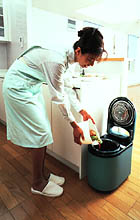MAKING TRASH POPULAR:
Household Garbage Processors a Big Hit with Consumers
February 23, 2000

Using a garbage processor. (Matsushita Electric Industrial Co., Ltd.)
Local governments throughout Japan have defined recycling and reducing the volume of trash as one of their top priorities for the new millennium. Citizens' attitudes are also changing; people everywhere are separating their trash into, for example, burnable, non-burnable, and recyclable waste. This is such a hot topic that tips for reducing the volume of trash are even appearing in magazines and on TV.
Biodegrading Versus Drying
As part of this trend, garbage processing machines for household use are becoming popular in Japan. These machines make kitchen waste easier to dispose of by decomposing, air-drying, or otherwise treating it. Leading appliance manufacturers are jumping into this market, and domestic demand, which was 180,000 units in fiscal 1998, is expected to grow to 300,000 units in fiscal 1999 and to reach between 500,000 and 600,000 units by fiscal 2000. These machines have become increasingly affordable, as prices for leading models have dropped below the 100,000 yen (909 U.S. dollars at 110 yen to the dollar) mark.
Machines based on various technologies are available, but the two most popular models are the biodegrading type, which uses wood shavings containing microorganisms to decompose garbage into components such as carbonic acid gas and water; and the drying type, which uses warm air to dry the garbage.
Biodegrading machines work by mixing household waste into wood shavings, in which microorganisms readily multiply. After 24 hours in this environment, the waste has been decomposed by the microorganisms. In processed form, the waste is only one-twentieth to one-eighth of its original volume. Not only that, the waste has been turned into organic fertilizer containing nutrients such as nitrogen, phosphoric acid, and potassium. Drying machines pulverize the waste, then air-dry it at 130 degrees Celsius (266 degrees Fahrenheit). In about two and a half hours, these machines can process 700 grams (1.55 pounds) of kitchen waste--about the amount produced by a typical family of four in one day--and reduce it to one-seventh of its original volume.
Each type of machine has advantages and disadvantages. Biodegrading machines produce fertilizer, making them attractive from a recycling standpoint. However, they give off an unpleasant odor, so they need to be kept outdoors. Drying machines are compact and possess strong deodorizing capabilities, so they can be kept indoors. They are more costly to run, however, because they require electricity. Furthermore, the units themselves cost about 20,000 yen (182 dollars) more than their biodegrading counterparts. The manufacturers of both types of machine have made performance improvements, such as reducing processing time, and have taken steps to remedy the unpleasant odors and hygiene concerns that arise when garbage is left standing for several days.
Subsidizing Waste Reduction
The main impetus for the spread of household garbage processing machines is that local governments are subsidizing their purchase. Kitchen waste is said to account for a third of household refuse. By reducing output at the household level, municipalities reduce the waste disposal burden that they themselves most shoulder. In fiscal 1997, fewer than 300 local governments offered subsidies to households for the purchase of garbage processing machines. About 1,000 are expected to do so in fiscal 1999.
Though the terms of the subsidies vary from one place to another, they are generally worth around 50% of the purchase price--about 20,000 yen (181.8 dollars) to 30,000 yen (272.7 dollars). In some places, both the city and the prefecture offer subsidies. Some residents of Fukui Prefecture who buy household garbage processors, for example, get up to two-thirds of the purchase price, up to 40,000 yen (363.6 dollars), subsidized by local government bodies. And in the spring of 1999, the city of Nagano raised its subsidy from 20% to 50% of the purchase price. As a result, orders for the appliances have quadrupled in the city over the past year.
At first, household garbage processing machines appealed mainly to gardeners, who saw the appeal of turning kitchen waste into fertilizer, and environmentalists. Now these appliances are becoming a fixture in other households too. Continuing research in this field is likely to yield further progress, that will allow manufacturers to keep coming up with competitive products.
 Edited by Japan Echo Inc. based on domestic Japanese news sources. Articles presented here are offered for reference purposes and do not necessarily represent the policy or views of the Japanese Government.
|




















